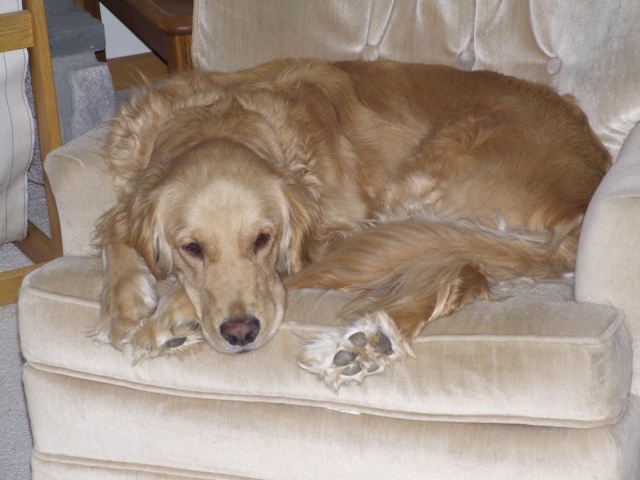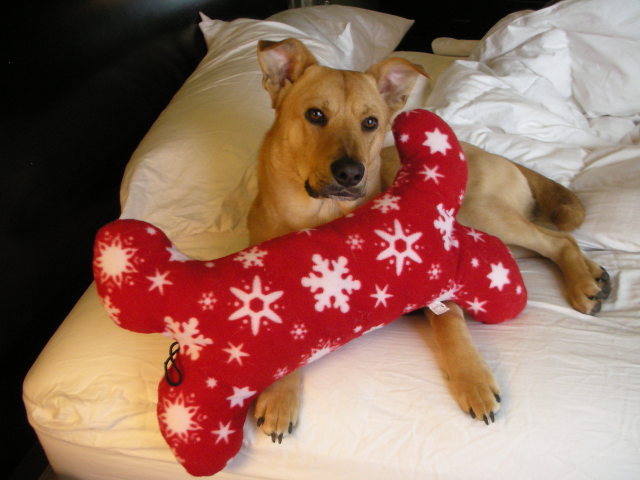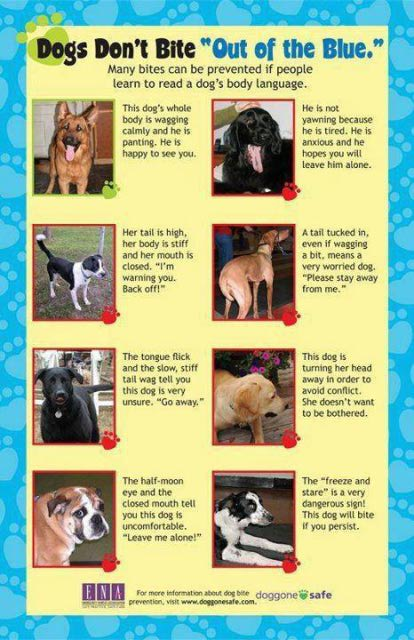QuestionWe have a 22 month spayed female golden retriever. She has been in an obedience training programme from 8 weeks. She is the most amazing trainable dog that I have ever had BUT when she gets in a situation of outside play she wants to dominate & play? very rough, jumping up, & showing her teeth. It is as if she suddenly thinks I am now vulnerable & she can become the leader. Consequently I can't play with her & feel sad about that. She is quite a nervous dog when faced with fierce dogs behind gates & is very submissive to any other dog even tiny ones. She is the only dog in the house with my husband & I and does get a lot of attention. I give her a long hour's walk most days, letting her off lead in the park.
AnswerI'm uncertain what you mean by "showing her teeth". There are various permutations associated with that behavior. A fear grimace can appear threatening to someone who doesn't recognize it and this sort of "grin" can also be a display of submission; the rest of the dog's body language is clearly communicating cause. Her "rough" and "jumping up" behavior may be an adjunct to her anxiety.
Eight weeks is extremely young for any dog to be in any "obedience" program; at that age, one concentrates on heavy socialization (with other dogs and people, etc.) not intensive instruction. Neonate puppies can be instructed but it needs to be done in very short multiple sessions and in a manner that rewards and never coerces. Since your dog displays submission to other dogs, I suspect the obedience "training" was not conducted using positive reinforcement OR the dog strongly associated her emotional response to the training (which her present behavior suggests was fearful) to the presence of other dogs and is now fearful of them.
Further, your behavior during "play" may be inappropriate; dogs learn to play and games with human conspecifics (especially those perceived as dominant or untrustworthy due to inappropriate training methods) put any dog (especially those who are extremely subdominant) in a position (psychologically) of confrontation in a manner that imitates a struggle for rank. Therefor, a dog that has been consistently trained (or at a strong fear period such as exists from 8 to 10 or 11 weeks of age) with coercion (the dog has not been allowed to make the CHOICE of working voluntarily) and is temperamentally fearful/submissive needs play interaction in a way specific to its experience.
This means: play must be structured. No dog should be allowed to get to a point where it is over excited or boisterous (jumping up). Play sessions should be calm; the dog should be taught to "take it/leave it" using reward, as seen here:
http://www.youtube.com/watch?v=ApIJV8oGphg&feature=related
Play is a social behavior with very clear signals (dog to dog) that remind the other dog "this is not serious". Even in what appears (to a human) to be a seriously rough play episode, each dog will periodically remind the other (either overtly, with play bow, or subtly with other calming signals) that "this is a game". Your dog is apparently misunderstanding this play interaction with you and she is MOST LIKELY giving you signals (stress reduction, calming) that you are not responding to (because you don't "talk dog" but she doesn't know that) and so her anxiety is escalating. Keep your games short AND SWEET. Surrender of a toy is accompanied with reward and praise; keep the toy at the end of the game. Remain calm; do not allow the dog to escalate in anxiety and behavior. If she begins to do so, ask for a 'sit' and heavily reward her, then end the game.
I suggest you learn to read your dog's body language. The most effective way to do this is to read/watch Turid Rugaas' book and video, "On Talking Terms with Dogs: Calming Signals", found here:
http://www.dogwise.com/itemdetails.cfm?ID=DTB527
I also suggest you re-evaluate the training method you have used. If you have NOT used positive reinforcement, START OVER, NOW. Learn about positive reinforcement at Dr. Ian Dunbar's site:
http://www.youtube.com/watch?v=Hv38ornzzuQ
Training, like any education process, is a lifelong event. The Golden is (historically) an excellent candidate for obedience BUT should have (breed was in trouble for a while) a bidable, subdominant temperament, meaning training must be done calmly, consistently and with reward ONLY. When a highly bidable dog (by breed type and/or temperament) is working for reward (voluntarily choosing to perform on cue), the dog's perception of its human conspecific is based upon trust and dependability (no "sudden" punishment or coercion, pain or fear). Once your dog is established in a working regimen based upon reward and has voluntarily chosen to work, you can use toys and short play intervals as reward. In this manner, the dog's cognition will be involved in these games with her and she will not revert to anxiety driven behaviors.

 aggression in aging dog
Question
Niko
I have a thirteen year old, female, Samoy
aggression in aging dog
Question
Niko
I have a thirteen year old, female, Samoy
 Very Scared Dog
Question
Happy
My dog is 17 months old and is a mixed b
Very Scared Dog
Question
Happy
My dog is 17 months old and is a mixed b
 Companion for Lonley Westie
Question
Shannon
We have a 5-year-old neutered Westie w
Companion for Lonley Westie
Question
Shannon
We have a 5-year-old neutered Westie w
 Is this aggression, dominance, or play?
QuestionQUESTION: I have a question regarding doggy beh
Is this aggression, dominance, or play?
QuestionQUESTION: I have a question regarding doggy beh
 Agressive 1 yr old mini goldendoodle
Question
our millie
My husband and I got our min
Agressive 1 yr old mini goldendoodle
Question
our millie
My husband and I got our min